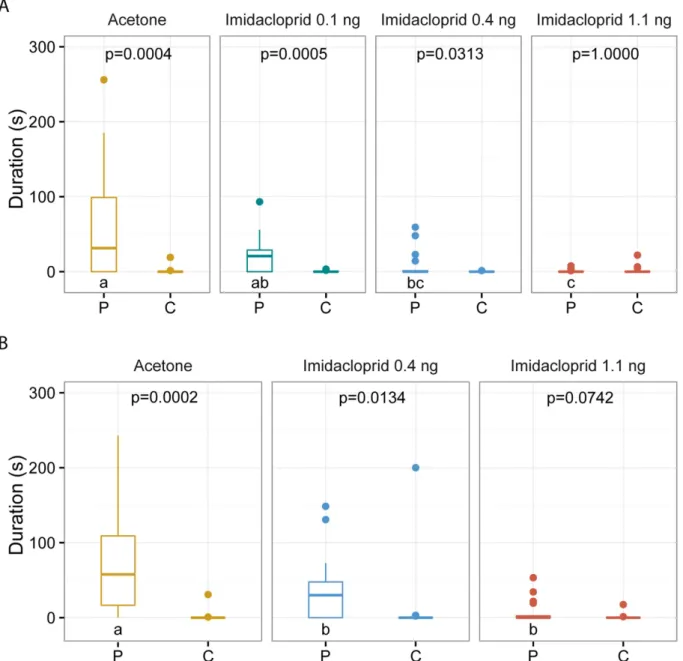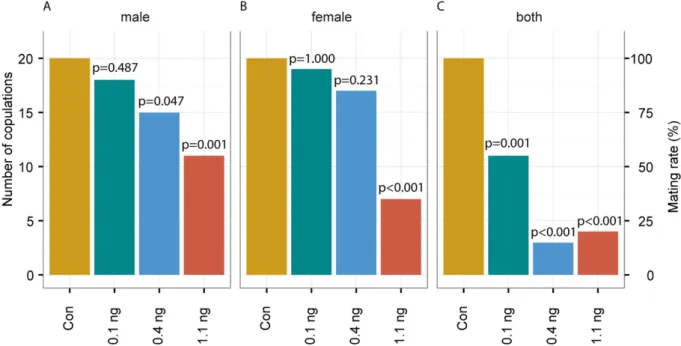www.nature.com/scientificreports
Sublethal doses of imidacloprid
disrupt sexual communication and host finding in a parasitoid wasp
Lars Tappert
1, Tamara Pokorny
1, John Hofferberth
2& Joachim Ruther
1Neonicotinoids are widely used insecticides, but their use is subject of debate because of their
detrimental effects on pollinators. Little is known about the effect of neonicotinoids on other beneficial insects such as parasitoid wasps, which serve as natural enemies and are crucial for ecosystem
functioning. Here we show that sublethal doses of the neonicotinoid imidacloprid impair sexual communication and host finding in the parasitoid wasp Nasonia vitripennis. Depending on the dose, treated females were less responsive to the male sex pheromone or unable to use it as a cue at all.
Courtship behaviour of treated couples was also impeded resulting in a reduction of mating rates by up to 80%. Moreover, treated females were no longer able to locate hosts by using olfactory cues. Olfaction is crucial for the reproductive success of parasitoid wasps. Hence, sublethal doses of neonicotinoids might compromise the function of parasitoid wasps as natural enemies with potentially dire consequences for ecosystem services.
The use of insecticides is a relatively cheap and effective way to control insect pests, but it poses ecological prob- lems by also affecting non-target organisms
1. This is particularly true for chemically stable broad-spectrum insecticides that might persist in the environment and accumulate in food chains. Apart from directly causing mortality or malformation, insecticides may also harm insects at sublethal doses, for instance after the consump- tion of contaminated pollen and nectar
2. Since many classes of insecticides are neurotoxins, they can have serious effects on the insects’ sensory system and thus impede their ability to acquire information from their environ- ment
3,4. Olfaction is of particular importance for reproduction and survival of most insect species
5. Hence, the disruption of olfaction by sublethal doses of insecticides might have severe consequences for the fitness of insects and severely compromise their contribution to ecosystem services
3.
Worldwide, the most applied insecticides are the neonicotinoids
6–8. They act selectively on the insect central nervous system by binding competitively to nicotinergic acetylcholine receptors
9. This causes a depolarization block of neuronal firing and inhibits nicotinergic responses even at sublethal doses, which results in an uncon- trolled continuous stimulation of the respective neurons and finally the death of the animal. The economic suc- cess of neonicotinoids is due to their high effectivity and relatively low toxicity for mammals
9. The development of resistances by many insect pests to other classes of insecticides additionally fostered the success of neonictinoids and resulted in a global market share of 28.5%
7. Neonicotinoids are typically used as seed coatings
10,11and act systemically, i.e., after germination, the pesticides are absorbed by the roots and transported via the xylem to the aboveground parts of the plant. They can be detected not only in the plant tissue but also in guttation drops
12, nectar and pollen
10,13and are thus, accessible to non-target insects
14. Because of their massive use in agriculture and a relatively high stability, neonicotinoids are persistent in the environment and occur even in ground water
14.
There is ample literature indicating detrimental effects of neonicotinoids on pollinators
1,15. In honeybees, sublethal doses of neonicotinoids impair orientation behaviour and foraging efficiency and cause increased mor- tality due to homing failure
16–19. Neonicotinoid treated honeybee workers show decreased sucrose responses (proboscis extension reflex) and are less active in performing “waggle dance”, an important component of for- ager recruitment
20. Furthermore, neonicotinoids have negative effects on the immune system of honeybees
21. In bumblebees, exposure to sublethal doses of neonicotinoids decrease foraging efficiency, fecundity and col- ony performance
22–24. A recent field study has revealed that coating of oilseed rape seeds with a combination of neonicotinoids and pyrethroids reduces wild bee abundance, solitary bee nesting, as well as bumblebee colony
1

